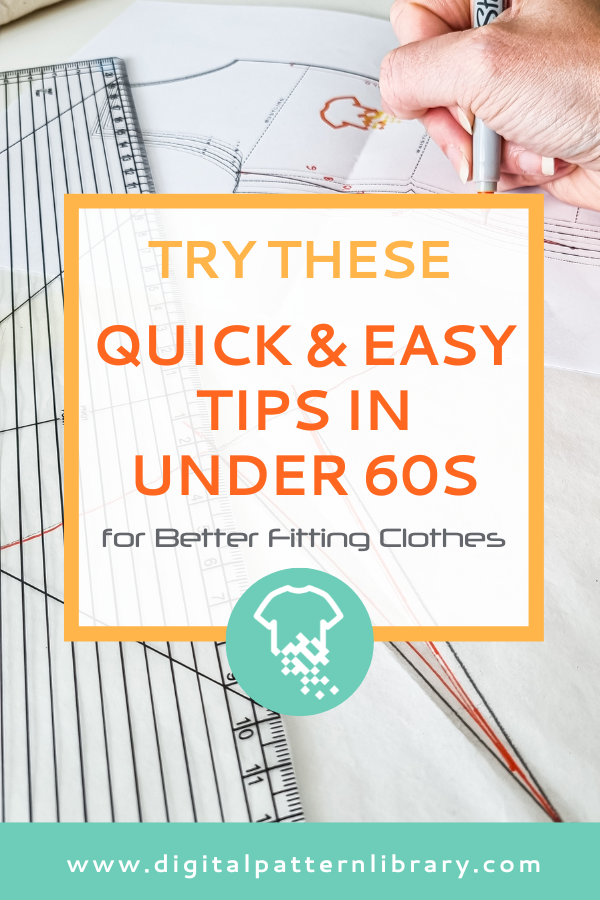Try These Quick and Easy Tips in Under 60 Seconds for Better Fitting Clothes
Creating or amending your own sewing patterns needn’t be an overwhelming task.
With home sewing having been on a steady increase since 2017, it’s no surprise that it’s not just skills at the machine we’re looking to develop. To truly create a wardrobe made to last, tailored to your body and true to your style and aesthetic, sooner or later getting involved with pattern amendments or drafting your own will crop up.
In The DPL Atelier we Create, Cut and Construct our dream wardrobes in a simple but powerful way, turning our 2D ideas into 3D sketches with ease. Today, I’m going to provide two super speedy techniques that will have you making small tweaks with big results for clothes that fit.
In fact, these methods are so fast, you can do them in under a minute.
Grading Between Sizes
Grading patterns is the process of scaling up or down between sizes without compromising on the proportion of the design. But what if you’re between sizes?
Trust me, I am still on a personal development journey of improving my patience. When the pretty fabric on the shelf is whispering sweet nothing’s into your ear, it takes all the discipline in the world not to start cutting in a desperate rush to wear that textile out IMMEDIATELY.
We’ve all been there at some point in our sewing journey. We’ve trusted a pattern, grabbed our material and sewn gung-ho into a garment that doesn’t fit us like we thought it would; only to feel deflated and take a knock in our confidence.
You’re not to blame for this, but I do encourage you to rewind, take a breather and grade between sizes before getting snip-happy with those scissors.
Firstly, it’s worth getting comfortable with your unique figure and dare I say, falling in love with it. I have a free tutorial available to help you take accurate measurements for fashion design.
Once you’ve made a note of these, select your pattern and cross-reference against the sizing chart provided.
Instead of cutting out one size and making dreaded amendments after the garment has been constructed, let’s amend the pattern in a matter of seconds before cutting, to accommodate your unique combination of measurements.
In this example I’ll talk you through grading between sizes on a basic bodice block, but the principles can be added to any pattern piece!
Step One
Cross-reference your measurements against that of the sizing chart provided and make a note of your bust, waist and hip in comparison to that of the sewing pattern.
Step Two
Mark your measurements onto the pattern.
For example, your bust may be a Size 14, waist Size 10 and hip Size 16.
Step Three
Join these lines together not forgetting to apply the changes to both front and back patterns.
Step Four
True your patterns.
Truing a pattern means smoothing the lines so there’s no sharp angles and making sure everything matches up. In the example shown, I would measure both front and back side seams to ensure they’re equal in length after grading between sizes.
That’s it! Deceptively easy, no? Depending on your pattern instructions you may need to add seam allowance. I’d encourage you to try this exercise regardless of your size to play around with truing out seams and the versatility of potential pattern shapes.
Reshaping Your Darts
The second speedy method is to reshape your darts to accommodate any unique fluctuations to your figure.
Whether you want to remove more fabric between the dart legs to contour the garment further to your hollows or add a bit more breathing space by concaving the dart legs out a bit.
This is an incredibly simple hack that ensures the waistline measurement remains unaltered yet still provides a tailored finish.
You can also lengthen or shorten the dart as required.
For example, if you were to add or remove just 3mm from each dart leg, you could introduce or exclude up to 1.2cm from the garment itself.
That’s 3mm per dart leg (3 x 2 = 6mm) and assuming you’re working on a symmetrical pattern, that would be applied to the mirrored side (6 x 2 = 12mm).
Of course these measurements may vary depending on your unique figure!
So there we have it. Two incredibly simple techniques and tweaks that can lead to powerful results, sure to elevate your sewing projects and fitting process. It’s always worth toiling your projects and creating a mock up in cheaper fabric to ensure these amendments are accurate but these really can be implemented in little to no time at all whilst offering you the confidence good fitting clothes can achieve.
If you want to take your pattern cutting journey further without the overwhelm, don’t forget I offer a free Pattern Cutting Basics course. This mini course has three curated lessons perfect for beginners to dip their toe or for more intermediate sewists to brush up on skills. You’ll learn tools and terminology, measurements and markings and some basic pattern manipulation techniques to really nurture your confidence.
As always I’m here to help if you’d like to email me with any questions, or better yet, find me at my best providing detailed support and tuition over in The DPL Atelier.
Stay safe and keep creative x




